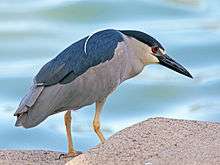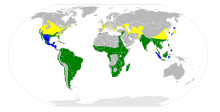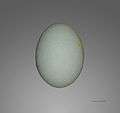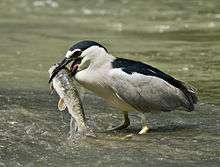Black-crowned night heron
| Black-crowned night heron | |
|---|---|
 | |
| Scientific classification | |
| Kingdom: | Animalia |
| Phylum: | Chordata |
| Class: | Aves |
| Order: | Pelecaniformes |
| Family: | Ardeidae |
| Genus: | Nycticorax |
| Species: | N. nycticorax |
| Binomial name | |
| Nycticorax nycticorax | |
 | |
| Range of N. nycticorax Breeding range Year-round range Wintering range | |
| Synonyms | |
|
Ardea nycticorax Linnaeus, 1758 | |
The black-crowned night heron (Nycticorax nycticorax), or black-capped night heron, commonly shortened to just night heron in Eurasia, is a medium-sized heron found throughout a large part of the world, except in the coldest regions and Australasia (where it is replaced by the closely related rufous night heron, with which it has hybridized in the area of contact).
Description
Adults are approximately 64 cm (25 in) long and weigh 800 g (28 oz). They have a black crown and back with the remainder of the body white or grey, red eyes, and short yellow legs. They have pale grey wings and white under parts. Two or three long white plumes, erected in greeting and courtship displays, extend from the back of the head. The sexes are similar in appearance although the males are slightly larger. Black-crowned night herons do not fit the typical body form of the heron family. They are relatively stocky with shorter bills, legs, and necks than their more familiar cousins, the egrets and "day" herons. Their resting posture is normally somewhat hunched but when hunting they extend their necks and look more like other wading birds.
Immature birds have dull grey-brown plumage on their heads, wings, and backs, with numerous pale spots. Their underparts are paler and streaked with brown. The young birds have orange eyes and duller yellowish-green legs. They are very noisy birds in their nesting colonies, with calls that are commonly transcribed as quok or woc.
Distribution
The breeding habitat is fresh and salt-water wetlands throughout much of the world. The subspecies N. n. hoactli breeds in North and South America from Canada as far south as northern Argentina and Chile, N. n. obscurus in southernmost South America, N. n. falklandicus in the Falkland Islands, and the nominate race N. n. nycticorax in Europe, Asia and Africa. Black-crowned night herons nest in colonies on platforms of sticks in a group of trees, or on the ground in protected locations such as islands or reedbeds. Three to eight eggs are laid.
This heron is migratory in the northernmost part of its range, but otherwise resident (even in the cold Patagonia). The North American population winters in Mexico, the southern United States, Central America, and the West Indies, and the Old World birds winter in tropical Africa and southern Asia.
A colony of the herons has regularly summered at the National Zoo in Washington, D.C. for more than a century.[2]
Status in Great Britain
There are two archaeological specimens of the black-crowned night heron in Great Britain. The oldest is from the Roman London Wall and the more recent from the Royal Navy's late medieval victualling yards in Greenwich[3] It appears in the London poulterers price lists as the Brewe, a bird which was thought to have been the Whimbrel or Glossy Ibis , which has now been shown to refer to the black-crowned night heron, derived from the medieval French Bihoreau.[4] Black-crowned night heron may have bred in the far wetter and wider landscape of pre-modern Britain. They were certainly imported for the table so the bone specimens themselves do not prove they were part of the British avifauna. In modern times the Black-crowned Night Heron is a vagrant and feral breeding colonies were established at Edinburgh Zoo from 1950 into the 21st Century[5] and at Great Witchingham in Norfolk where there were 8 pairs in 2003 but breeding was not repeated in 2004 or 2005.[6] A pair of adults were seen with two recently fledged juveniles in Somerset in 2017, which is the first proven breeding record of wild black-crowned night herons in Great Britain.[7]
Behaviour
These birds stand still at the water's edge and wait to ambush prey, mainly at night or early morning. They primarily eat small fish, crustaceans, frogs, aquatic insects, small mammals, and small birds. They are among the seven heron species observed to engage in bait fishing; luring or distracting fish by tossing edible or inedible buoyant objects into water within their striking range – a rare example of tool use among birds.[8][9] During the day they rest in trees or bushes. N. n. hoactli is more gregarious outside the breeding season than the nominate race.
 Egg
Egg.jpg) N. n. hoactli, Tobago
N. n. hoactli, Tobago
 Feeding
Feeding Juvenile in flight, San Rafael, California
Juvenile in flight, San Rafael, California Wading, Arches National Park, Utah
Wading, Arches National Park, Utah Black-crowned Night-Heron Nycticorax nycticorax collageTamil nadu
Black-crowned Night-Heron Nycticorax nycticorax collageTamil nadu
Parasites
A thorough study performed by J. Sitko and P. Heneberg in the Czech Republic in 1962–2013 suggested that the central European black-crowned night herons host 8 helminth species. The dominant species consisted of Neogryporhynchus cheilancristrotus (62% prevalence), Contracaecum microcephalum (55% prevalence) and Opistorchis longissimus (10% prevalence). The mean number of helminth species recorded per host individual reached 1.41. In Ukraine, other helminth species are often found in black-crowned night herons too, namely Echinochasmus beleocephalus, Echinochasmus ruficapensis, Clinostomum complanatum and Posthodiplostomum cuticola.[10]
Etymology
Nycticorax means "night raven" and derives from the Ancient Greek nuktos "night" and korax, "raven". It refers to the largely nocturnal feeding habits and croaking crow-like call of this species.[11]
In the Falkland Islands, the bird is called "quark", which is an onomatopoeia similar to its name in many other languages, like "qua-bird" in English, "kwak" in Dutch and West Frisian, "kvakoš noční" in Czech, "квак" in Ukrainian, "кваква" in Russian, "vạc" in Vietnamese, "kowak-malam" in Indonesian, and "waqwa" in Quechua.
References
- ↑ BirdLife International (2012). "Nycticorax nycticorax". IUCN Red List of Threatened Species. Version 2013.2. International Union for Conservation of Nature. Retrieved 26 November 2013.
- ↑ Akpan, Nsikan (12 May 2015). "Smithsonian's mystery of the black-crowned night herons solved by satellites". PBS News Hour. PBS. Retrieved 2 May 2016.
- ↑ D.W Yalden; U. Albarella (2009). The History of British Birds. Oxford University Press. ISBN 978-019-958116-0.
- ↑ W.R.P. Bourne (2003). "Fred Stubbs, Egrets, Brewes and climatic change". British Birds. 96: 332–339.
- ↑ R.W. Forrester; I.J. Andrews, eds. (2007). The Birds of Scotland Volume 1. Scottish Ornithologists' Club. ISBN 978-0-9512139-0-2.
- ↑ Holling M. and the Rare Breeding Birds Panel (2007) Non-native breeding birds in the United Kingdom 2003, 2004 and 2005 British Birds 100 638–649
- ↑ "Night Herons breed in Somerset - a UK first". Rare Bird Alert. Retrieved 2 August 2017.
- ↑ Riehl, Christina (2001). "Black-Crowned Night Heron Fishes with Bait". Waterbirds: The International Journal of Waterbird Biology. 24 (2): 285–286. doi:10.2307/1522044. JSTOR 1522044.
- ↑ Ruxton, Graeme D.; Hansell, Michael H. (2011-01-01). "Fishing with a Bait or Lure: A Brief Review of the Cognitive Issues". Ethology. 117 (1): 1–9. doi:10.1111/j.1439-0310.2010.01848.x. ISSN 1439-0310.
- ↑ Sitko, J.; Heneberg, P. (2015). "Composition, structure and pattern of helminth assemblages associated with central European herons (Ardeidae)". Parasitology International. 64: 100–112. doi:10.1016/j.parint.2014.10.009.
- ↑ Jobling, James A (2010). The Helm Dictionary of Scientific Bird Names. London: Christopher Helm. p. 277. ISBN 978-1-4081-2501-4.
Further reading
- Black-crowned night heron on Animal Diversity Web
- Stiles, F. Gary; Skutch, Alexander F. (1990). A Guide to the Birds of Costa Rica. Cornell University Press. ISBN 978-0-8014-9600-4.
- Hancock, James (1999). Herons and Egrets of the World. Academic Press. ISBN 0-12-322725-9.
- Sibley, David (2000). The Sibley Guide to Birds. Knopf. ISBN 978-0-679-45122-8.
External links
| Wikimedia Commons has media related to Nycticorax nycticorax. |
| Wikispecies has information related to Nycticorax nycticorax |
- Blasco-Zumeta, Javier; Heinze, Gerd-Michael. "Black-crowned night heron" (PDF). Identification Atlas of Aragon's Birds.
- Black-crowned Night-Heron Species Account – Cornell Lab of Ornithology
- Black-crowned night-heron - Nycticorax nycticorax - USGS Patuxent Bird Identification InfoCenter
- Blackcrowned Night Heron - The Atlas of Southern African Birds
- Black-crowned Night-Heron Nycticorax nycticorax - eNature.com
- Field Guide on Flickr
- Images and information of the black-crowned night heron from Portugal
- "Black-crowned night-heron media". Internet Bird Collection.
- Black-crowned night-heron photo gallery at VIREO (Drexel University)
